
In a bid to transform neglected urban areas into vibrant communities and address the housing crisis, the UK government has announced the opening of the third and final round of the Brownfield Land Release Fund 2.
With an allocation of up to £80 million, this fund aims to facilitate the development of over 8,000 new homes on brownfield sites owned by local councils by March 2028.
Minister for Housing, Lee Rowley, expressed the government's commitment to utilising brownfield land for housing to fulfil the Long-Term Plan for Housing and to "level up" the country. The Brownfield Land Release Fund 2 is a crucial component of the government's overarching plan, with the goal of delivering one million homes over the current parliamentary term.
Rowley stated: "This fund will transform unloved and unused brownfield sites into thriving new communities, helping more young families onto the property ladder and creating thousands of jobs. This is a game changer for councils and I strongly encourage them to apply and reap the benefits in their local areas."
The fund, totalling £180 million, was launched in July 2022 and is designed to rejuvenate neglected urban spaces, support regeneration projects and stimulate local economies. Cabinet Officer Minister Alex Burghart emphasised the positive impact the funding would have on redevelopment efforts, stating that it will stimulate growth, investment and job opportunities.
"This funding will help unlock much-needed redevelopment of unloved, previously derelict brownfield sites: stimulating growth, investment and job opportunities. It's fantastic news for business, and even better news for local people who will now see new family homes in their communities," said Burghart.
The Local Government Association (LGA) has played a pivotal role in facilitating the success of the Brownfield Land Release Fund 2. Shaun Davies, Chair of the LGA, highlighted the positive outcomes of the first two rounds of funding, expressing satisfaction that the LGA continues its partnership with relevant government departments to help councils access the latest round of the fund.
Davies remarked: "The One Public Estate program has helped to shape this latest funding offer to ensure it can help as many councils as possible bring forward viable housing schemes on their land. I would urge councils to consider how this third round of BLRF2 can help them address local housing needs and support placemaking and regeneration ambitions."
The Brownfield Land Release Fund 2 has already made a significant impact, supporting projects in various regions, including Bognor Regis, Rochdale and Somerset. The previous rounds of funding have contributed to the unlocking of new homes and supported accommodations for homeless individuals.
To date, the fund has supported 89 local authorities, and over 160 projects and provided over £100 million to release land for almost 8,600 homes. The full brownfield fund is expected to deliver over 17,600 new homes and create 56,000 skilled jobs over the next four years, contributing to the government's vision of levelling up communities across the country.
The final round of Brownfield Land Release Fund 2 funding is open to local authorities across England, with the application window closing on 14th February 2024. Successful projects are anticipated to be announced in the summer of 2024. The funds awarded to local authorities will be utilised for land remediation and small-scale infrastructure work, making surplus brownfield sites ready for housing that would otherwise remain derelict.
The Brownfield Land Release Fund 2 is a part of the government's broader planning reforms outlined in the Levelling Up and Regeneration Act, which has recently become law. The Act underscores a brownfield-first approach to development, aligning with the government's commitment to sustainable urban growth and environmental conservation.
As local authorities gear up to submit their bids for a share of the final round of funding, there is optimism that this initiative will not only provide much-needed housing solutions but also contribute to the economic revitalisation of communities, creating a positive ripple effect for years to come.







